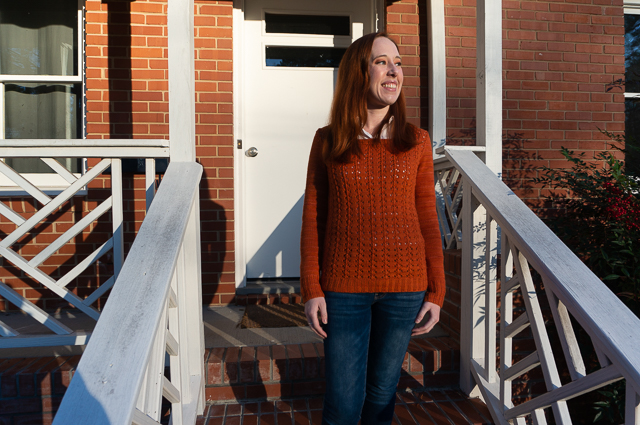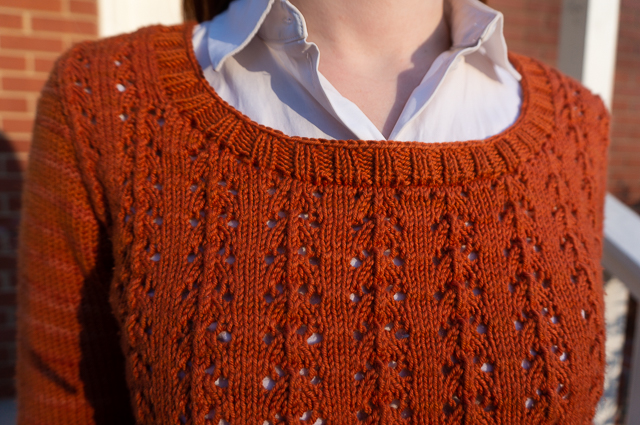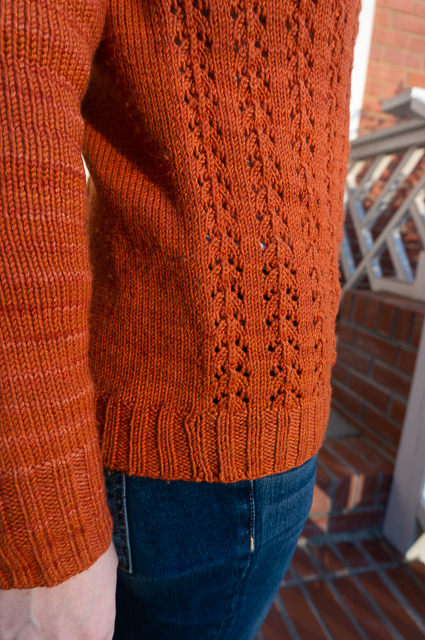





In the early, sporadic days of my knitting, when I was making the transition from wistfully reading knitting blogs to actually doing some knitting myself, I had the great good fortune to stumble upon TECHknitter. Though their identity remains (to me, at least) a mystery, they are clearly a capable and inventive knitter, because their blog, which spans more than 10 years, is really an electronic book full of improved solutions to many of knitting’s everyday challenges. From them I have learned a gap-less, jog-less way to join a piece of work in the round, three ways to bind off circular knits depending on the type of project, and ten methods for weaving in ends (though I’ve only used four or five of them to date).
Much of TECHknitter’s writing deals with the mechanics of knitting, like why a stockinette edge curls (and why adding a border doesn’t really fix the problem), and how to use that knowledge to your advantage. But sprinkled throughout are bits of knitting philosophy, such as when to choose an excellent but fiddly solution and when to settle for a pretty good one. Very occasionally—only a handful of times in a decade—TECHknitter treats the reader to a pure philosophical refection on the craft.
The one that’s stuck with me, that continues to thread itself through more and more of my thinking, is the work-to-glory ratio. Originally posited by TECHknitter’s friend Carol, the work-to-glory ratio is the relationship between the amount of effort that goes into a project and the degree to which the result is impressive or satisfying. A project that appears difficult but was in fact easy to knit has a good work-to-glory ratio, whereas a project that was tedious or hard and turns out indistinguishable from something machine-made has a bad work-to-glory ratio.
As TECHknitter is quick to point out, there are of course plenty of projects that are both challenging and gratifying: some projects are rewarding precisely because of the time and effort that went into their making. A practical project in a workhorse yarn with a familiar pattern might turn out precisely as useful as the knitter intended. For TECHknitter, the work-to-glory ratio is more an observable phenomenon than a guiding principle.
The orange sweater above, a CustomFit version of Amy Herzog’s Foyle’s Pullover, has proven to have a pretty good work-to-glory ratio. The allover lace on the front is an easy-to-read and memorize six-row repeat where the wrong-side rows are all purled, and it’s a great design to practice decreasing in pattern (though no specific instructions are given for this, and the source I was going to recommend is no longer available online). Meanwhile, the back and sleeves are simple stockinette, yet these large swaths of plain stitching somehow recede into the background so as not to draw attention to the fact that two-thirds of the sweater are mindless TV knitting.
While to my eye there’s nothing really outstanding about this pullover, everyone who’s seen me wear it has been impressed by its handmade origins and convinced that it must have been quite a bit of work to produce. Oh no, I think, it wasn’t nearly as fraught re-knitting every piece of this sweater to get a mediocre fit, or as mind-meltingly tedious as dealing with the kajillion ends on this one to make it wearable. Both of those projects took far more time and mental energy, but you’d never know it by looking at them.
(In case anyone thinks I’m underwhelmed by the results here, let me assure you that I’m very happy with the outcome and feel it’s my best CustomFit sweater yet.)

The work-to-glory ratio as a framework for thinking about things that take work—even if they’re not thought of as work, as a task or a job—has slowly crept into other areas of my life. Increasingly I’ve been thinking about it in the context of friendships, and I’ve been struck by how even a healthy friendship can at times have a pretty poor work-to-glory ratio.
The daily work of being friends, of nurturing a relationship, can involve so many small acts to affirm, question, encourage, and comfort. Making time to call, remembering milestones, knowing a person’s favorite treat or pet peeves—these are all part of the skill of being a friend, a skill that must be learned and can be cultivated.
But it’s also work that can go unrewarded. A deliberate effort to ask about something a friend is working on might lead to a dead-end in conversation; a genuine desire to check up on their wellbeing might go completely unanswered or unacknowledged. Frequent small touches become shallow interactions, which can start to feel like more of a rote exercise than the practice of making a genuine human connection.
In my lowest moments, I wonder if the work isn’t worth the paltry sum of glory.
And yet TECHknitter offers another way of thinking about this too: work as product plus process. The idea that the value of a thing lies in the thing itself, and also in all of the moments that went into making the thing added up. A handknit sock is no longer just a sock: it’s an act of care, patiently created to be something functional and comfortable and beautiful that someone can use and enjoy every day. The knitter knows it, and so does the wearer, and that knowing is as much as part of the joy as the sock itself.
The time, place, and emotional space the knitter was in while they knit are also part of that sock, whether the wearer knows it or not. They become folded into the process part of the equation, bringing further dimensions to that sock’s intangible value.
But beyond even these things are the very act of making itself: the friction of yarn sliding over the tensioning finger, the clicking of needles in motion, the rhythm of forming stitches and turning the work. Watching the balance of yarn change, the unraveled cake collapsing as the yarn is raveled back into a slowly lengthening sock. Choosing to see and hear and feel the process of yarn becoming a sock when it would be far faster and simpler to buy socks at the store.
How much better to think of friendships as product plus process! To imagine each moment of connection, no matter how seemingly trivial, as another stitch in the knitting—by itself practically inconsequential, but in aggregate absolutely essential. To treat the intention behind each small act of kindness as equal to the outcome of the act in importance. The goodness of a friendship is thus measured not only in how meaningful are the conversations or how memorable the events, but also in how much love and concern motivated every effort to have those moments, even when those efforts appear to fail.
The work of friendship and the rewards of friendship are not two sides of an equation to be weighed against each other: a friendship is the sum of the work and the rewards, the product and the process added up and divided between friends.
